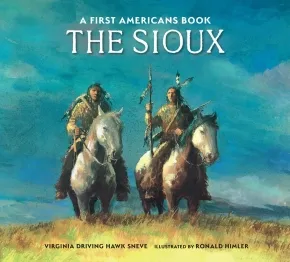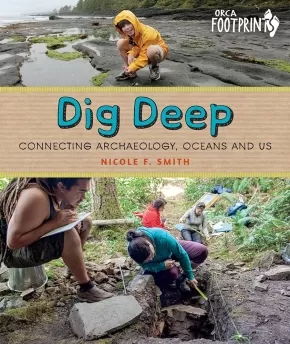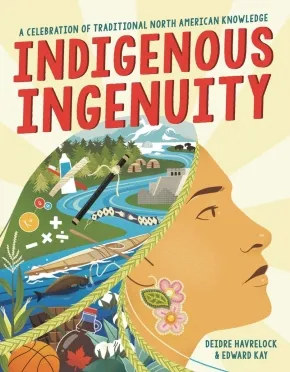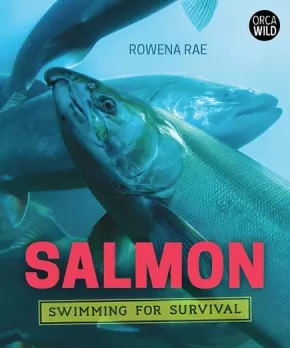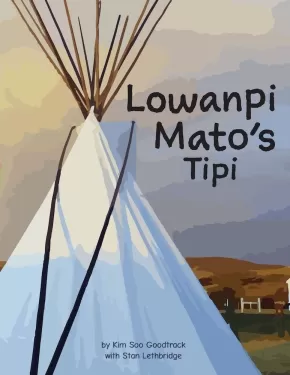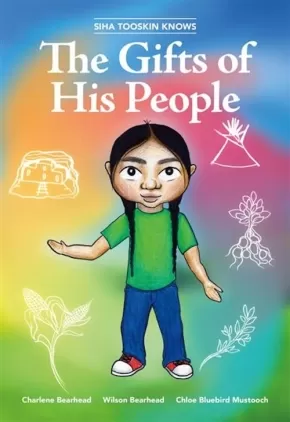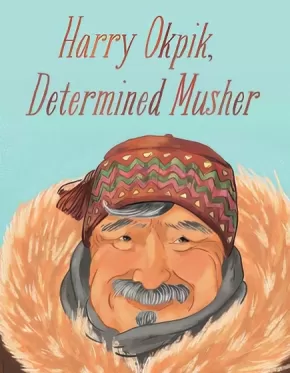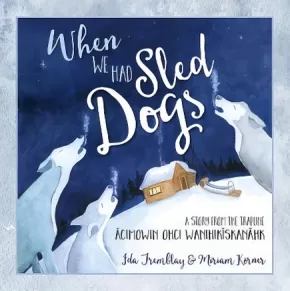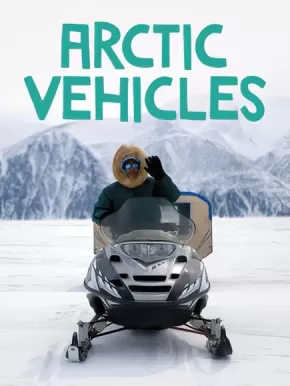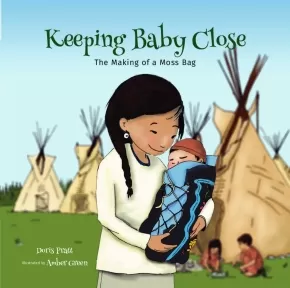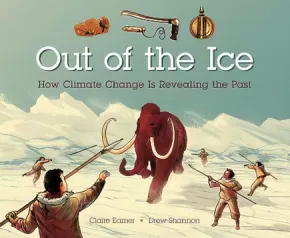
Indigenous Technology
1
-
15
of
24 Results;
Sort By
Go To
of 2
The Sioux
$12.49
Artists:
Format:
Paperback
Text Content Territories:
Indigenous American; Native American; Sioux;
ISBN / Barcode: 9780823460953
Synopsis:
Synopsis:
Award-winning author Virginia Driving Hawk Sneve introduces young readers to the Sioux peoples.
The buffalo was the center of Sioux life. After hunting buffalo on horseback, the Sioux people would use every piece of the animal, making food, beds, clothing, storage boxes, and even sleds from the ribs! Discover how the Sioux people lived on the Great Plains with this accessible introduction. Learn about the Sioux creation story, life in the village as a kid, the importance of their feathered headdresses, and more.
This updated edition provides the most up to date and accurate information on the Sioux people of past and present. The back of the book includes a section on Sioux life today, proper names for all of the Sioux tribes, and an excerpt from the Lakota pipe ceremony.
Educator & Series Information
Recommended for ages 7 to 10.
This book is part of the First Americans series.
Additional Information
32 pages | 10.55" x 9.47" | Paperback
Making Rope Out of Bearded Sealskin
$15.95
Artists:
Format:
Paperback
Text Content Territories:
Indigenous Canadian; Inuit;
ISBN / Barcode: 9781774507971
Synopsis:
Synopsis:
Learn all about the process of making rope from bearded seal skin! Rope is a very useful tool and is used by Inuit for many things. From removing the blubber to hanging the rope to dry, this introductory guide takes readers through a step-by-step process for making rope from bearded seal skin.
Educator Information
Recommended for ages 6 to 8.
Making Rope Out of Bearded Sealskin gives simple, step-by-step instructions on how to make rope out of bearded sealskin and describes other things Inuit make out of sealskin.
Additional Information
24 pages | 8.00" x 10.00" | Paperback
Dig Deep: Connecting Archaeology, Oceans and Us
$21.95
Format:
Hardcover
Text Content Territories:
Indigenous; Indigenous Canadian; First Nations; Indigenous American; Native American;
ISBN / Barcode: 9781459826083
Synopsis:
Synopsis:
What can archaeology and Indigenous Traditional Knowledge tell us about how our marine environments have changed over time and the effects of climate change?
From harvesting herring eggs to hunting humpback whales, humans have had a relationship with the world's oceans for more than 100,000 years. In Dig Deep: Connecting Archaeology, Oceans and Us, young readers unearth what our ancestors left behind at archaeological sites around the world and examine how tools, campsites, fishing technologies and even garbage can show us how our ancestors lived and how they used the ocean. These discoveries can unearth clues to help keep our oceans healthier today and in the future.
Reviews
“Provides readers with an introduction to archeology…Slim yet informative…Recommended.” — School Library Connection
Educator & Series Information
Recommended for ages 9 to 12.
This book is part of the Orca Footprint series.
Additional Information
48 pages | 8.00" x 9.50" | Hardcover
Indigenous Ingenuity: A Celebration of Traditional North American Knowledge (PB)
$12.99
Artists:
Format:
Paperback
ISBN / Barcode: 9780316413435
Synopsis:
Synopsis:
Celebrate Indigenous thinkers and inventions with this beautifully designed, award-winning interactive nonfiction book—perfect for fans of Braiding Sweetgrass.
Corn. Chocolate. Fishing hooks. Boats that float. Insulated double-walled construction. Recorded history and folklore. Life-saving disinfectant. Forest fire management. Our lives would be unrecognizable without these, and countless other, scientific discoveries and technological inventions from Indigenous North Americans.
Spanning topics from transportation to civil engineering, hunting technologies, astronomy, brain surgery, architecture, and agriculture, Indigenous Ingenuity is a wide-ranging STEM offering that answers the call for Indigenous nonfiction by reappropriating hidden history. The book includes fun, simple activities and experiments that kids can do to better understand and enjoy the principles used by Indigenous inventors. Readers of all ages are invited to celebrate traditional North American Indigenous innovation, and to embrace the mindset of reciprocity, environmental responsibility, and the interconnectedness of all life.
Reviews
"An astonishing, exuberant treasure trove of history, science and hands-on activities that repeatedly begs the question: "Why didn't I know this?" Essential for kids and adults. We need this book." —Candace Fleming, award-winning author of The Rise and Fall of Charles Lindbergh and The Family Romanov
"This book will amaze readers and teachers as it demonstrates how pervasive and critical the history of Indigenous people is. A completely unique and important narrative not to be missed; readers and teachers will come away with a new appreciation for the myriad contributions Indigenous people have made."—SLJ, starred review
"A conversational tone invites readers to engage with this monumental collection . . . Curious readers will learn facts unique to individual tribal groups while gaining knowledge of STEM/STEAM concepts. An ambitious, appealing, and accessible work documenting and protecting valuable knowledge."—Kirkus Reviews
"Engaging and informative, this will be welcomed by both STEM and social studies curricula to help to correct prevailing narratives about Indigenous technology."—Booklist, starred review
"Via authoritative, meticulously researched prose, the creators detail Native peoples’ significant strides in scientific pursuits . . . [and] showcase Native tribes’ continual and enduring impact. Photographs, as well as interactive activities detailing recipes and science experiments, feature throughout, lending a hands-on approach to this clear and concise work."—Publishers Weekly
"This book is a valuable contribution to efforts to decolonize learning and introduce readers to the breadth of indigenous knowledge as practiced in widely disparate geographic zones."—Canadian Review of Materials
"An engaging and cleverly compiled guide to North American and Mesoamerican Indigenous innovation. STEM topics (housing, medicine, clothing, agriculture, and hunting among them) are compellingly and conversationally discussed."—Shelf Awareness
Educator Information
Recommended for ages 8 to 12.
Fountas & Pinnell Text Level Gradient: Z
Additional Information
288 pages | 6.95" x 9.00" | Paperback
Salmon: Swimming for Survival
$24.95
Format:
Hardcover
Text Content Territories:
Indigenous;
ISBN / Barcode: 9781459826533
Synopsis:
Synopsis:
Salmon: Swimming for Survival introduces us to the dramatic life story of salmon.
These fish hatch in streams, swim extreme distances out to sea, and then migrate home to where they were born to produce the next generation. But today their habitats and very survival are threatened by human activity. This book looks at the unique biology of salmon, their importance to many Indigenous communities, their cultural and economic impact and the vital role they play in ecosystems. With profiles from scientists, educators, fishers and more, learn about the people who are working hard to change the uncertain future of salmon and improve the chance that these iconic fish can survive for generations to come.
Reviews
“A wealth of good, up-to-date information...This comprehensive book has a great deal to offer to help everyone understand the critical nature of salmon conservation. Highly Recommended.” — CM: Canadian Review of Materials
“This informative book...takes a complex subject and breaks it down into parts that are easy to comprehend. Recommended.” — School Library Connection
Educator & Series Information
This book is part of the Orca Wild series that examines the intricacies of animals, ecosystems, humans and our relationships to each other.
Recommended for ages 9 to 12.
Includes some Indigenous content.
Additional Information
112 pages | 7.50" x 9.00" | Hardcover
Inuit Tools of the Western Arctic - Nunavummi Reading Series
$10.95
Artists:
Format:
Paperback
Text Content Territories:
Indigenous Canadian; Inuit;
ISBN / Barcode: 9781774500583
Synopsis:
Synopsis:
There are many tools used in the western part of the Arctic! Learn about these tools and their different uses, from softening skins to pounding seal fat.
Educator & Series Information
This book is part of the Nunavummi Reading Series, a Nunavut-developed series that supports literacy learning while teaching readers about the people, traditions, and environment of the Canadian Arctic. It is a Level 8 book in the series.
Nunavummi Reading Series books have also been officially levelled using the Fountas & Pinnell Text Level Gradient™ Levelling System. This book's F&P Level is K.
Recommended for ages 5 to 7.
Additional Information
20 pages | 7.00" x 9.00"
Lowanpi Mato’s Tipi
 $18.50
$18.50

Artists:
Format:
Hardcover
Text Content Territories:
Indigenous Canadian; First Nations; Sioux; Lakota;
ISBN / Barcode: 9781771744751
Synopsis:
Synopsis:
“Hokahe! Welcome!”
Welcome to Wood Mountain, home of the Lakota People, in southern Saskatchewan. It is here that we meet Stan Lethbridge, whose ancestral name is Lowanpi Mato (Singing Bear).
Join Lowanpi Mato as he prepares to set up his summer Tipi. He shares with us Lakota life values and traditions, and how they connect to building and taking care of a Tipi. He teaches us that to build a Tipi you need many items; some are from natural sources and others are purchased from a store. Lowanpi Mato takes us through a step-by-step building process so that we can all learn how a Tipi is built.
The Lakota language is woven throughout the story. The Lakota counting chart on pages 30 and 31 invites you to learn to count and have some fun looking back through the book to find items that match each number.
Welcome to Wood Mountain, home of the Lakota People, in southern Saskatchewan. It is here that we meet Stan Lethbridge, whose ancestral name is Lowanpi Mato (Singing Bear).
Join Lowanpi Mato as he prepares to set up his summer Tipi. He shares with us Lakota life values and traditions, and how they connect to building and taking care of a Tipi. He teaches us that to build a Tipi you need many items; some are from natural sources and others are purchased from a store. Lowanpi Mato takes us through a step-by-step building process so that we can all learn how a Tipi is built.
The Lakota language is woven throughout the story. The Lakota counting chart on pages 30 and 31 invites you to learn to count and have some fun looking back through the book to find items that match each number.
Educator Information
Lakota language is woven throughout this story, as are the seven values of Lakota life.
Lakota language is woven throughout this story, as are the seven values of Lakota life.
Includes a counting chart from 1 to 20 in Lakota, as well as a search-and-find counting game.
Additional Information
32 pages | 8.5" x 11" | Hardcover | ISBN: 9781771744751
32 pages | 8.5" x 11" | Hardcover | ISBN: 9781771744751
Siha Tooskin Knows the Gifts of His People
$11.95
Format:
Paperback
Text Content Territories:
Indigenous Canadian; First Nations; Stoney-Nakoda (Nakota);
ISBN / Barcode: 9781553798347
Synopsis:
Synopsis:
Transportation, housing, agriculture, communications…there are so many modern conveniences. But are they really modern? Where did they really come from?
Paul Wahasaypa—Siha Tooskin—will learn about their origins and more on his walk home from school with Ade (his father). There’s so much to learn about the earliest forms of technology, travel, medicine, and food from right here on Turtle Island. Come along with Paul and Ade to hear all about the gifts of his people.
The Siha Tooskin Knows series uses vivid narratives and dazzling illustrations in contemporary settings to share stories about an 11-year-old Nakota boy.
Educator & Series Information
The Siha Tooskin Knows series uses vivid narratives and dazzling illustrations in contemporary settings to share stories about an 11-year-old Nakota boy. Explore Nakota culture and traditions alongside Paul Wahasaypa and his community in this eight-book series.
Key Features:
- A coming-of-age story about a Nakota boy learning about his identity and developing a sense of cultural responsibility in a contemporary, urban setting. Also touches on issues of environmental ecology and bullying.
- Charlene Bearhead and Wilson Bearhead are both well-respected and accomplished educators and storytellers.
- A part of the Siha Tooskin Knows series with teachings that show an Indigenous community and family in a positive light.
- Nakota lessons aim for universality, informing both Indigenous and non-Indigenous readers.
- This book illustrates how traditional teachings can play a vital role in contemporary life.
- Dynamic illustrations by Nakota artist Chloe Bluebird Mustooch bring this story to life.
Recommended for ages 9 to 11. Early Chapter Books.
This fictional story talks about the earliest forms of technology, travel, medicine, and food and could be used for social studies, explorations of Indigenous technology/history, etc.
Additional Information
24 pages | 5.50" x 8.00" | Colour Illustrations
Harry Okpik, Determined Musher - Nunavummi Reading Series
$16.95
Artists:
Format:
Hardcover
Text Content Territories:
Indigenous Canadian; Inuit;
ISBN / Barcode: 9781772665758
Synopsis:
Synopsis:
Meet a real-life Inuit hero!
This book introduces the biography genre while teaching children about the life of Harry Okpik and the history of dogsledding.
Educator & Series Information
This book is part of the Nunavummi Reading Series, a Nunavut-developed series that supports literacy learning while teaching readers about the people, traditions, and environment of the Canadian Arctic. It is a Level 13 book in the series.
Nunavummi Reading Series books have also been officially levelled using the Fountas & Pinnell Text Level Gradient™ Levelling System. F&P Level of this book: N.
Curriculum Connections: Language and Literacy; Diversity; Indigenous Perspectives; Identity; Self-Image
Recommended for ages 7 to 9.
Additional Information
52 pages | 7.50" x 9.30"
Things That Move in the Arctic - Nunavummi Reading Series
$7.95
Format:
Paperback
Text Content Territories:
Indigenous Canadian; Inuit;
ISBN / Barcode: 9780228702030
Synopsis:
Synopsis:
Learn about transportation in the Arctic!
This book features traditional and modern ways of getting around in the Arctic.
Educator & Series Information
This book is part of the Nunavummi Reading Series, a Nunavut-developed series that supports literacy learning while teaching readers about the people, traditions, and environment of the Canadian Arctic. It is a Level 3 book in the series.
Nunavummi Reading Series books have also been officially levelled using the Fountas & Pinnell Text Level Gradient™ Levelling System. This book's F&P Level is LB.
Curriculum Connections: Language and literacy; Indigenous perspectives; Community engagement; History; Heritage
Recommended for ages 3-6.
Additional Information
12 pages | 6.00" x 8.00"
When We Had Sled Dogs: A Story from the Trapline - ācimowin ohci wanihikīskanāhk (HC) (4 in Stock)
$22.95
Artists:
Format:
Hardcover
Text Content Territories:
Indigenous Canadian; First Nations; Cree (Nehiyawak);
ISBN / Barcode: 9781988783390
Synopsis:
Synopsis:
When We Had Sled Dogs: A Story from the Trapline - ācimowin ohci wanihikīskanāhk takes readers young and old on a journey into the past when dog teams were part of the traditional way of life in Northern Saskatchewan. Inspired by Elder Ida Tremblay’s childhood memories, and told in English with Woodland Cree words and phrases, the story follows the seasonal cycle of trapline life.
Educator Information
Recommended for ages 5 - 10.
Delivered in English with Woodland Cree words and phrases.
This resource is recommended in the Canadian Indigenous Books for Schools 2020/2021 resource list for grades K to 4 for use in these areas: Social Studies, English Language Arts, and Career Education.
Additional Information
|
Arctic Vehicles - Nunavummi Reading Series (3 in Stock)
$8.95
Format:
Paperback
Text Content Territories:
Indigenous Canadian; Inuit;
ISBN / Barcode: 9781772668759
Synopsis:
Synopsis:
What kinds of vehicles do people use in the North?
This non-fiction book introduces children to some of the means of transportation Nunavummiut use in the Arctic.
Educator Information
This book is part of the Nunavummi Reading Series, a Nunavut-developed series that supports literacy learning while teaching readers about the people, traditions, and environment of the Canadian Arctic. It is a Level 9 book in the series.
Nunavummi Reading Series books have also been officially levelled using the Fountas & Pinnell Text Level Gradient™ Levelling System. This book's F&P Level is J.
Curriculum Connections: Language and literacy; Diversity; Indigenous perspectives; History; Heritage.
Recommended for ages 5-7.
Additional Information
20 pages | 6.00" x 8.00"
Grandpa, How Do I Build an Iglu? - Nunavummi Reading Series
$10.95
Artists:
Format:
Paperback
Text Content Territories:
Indigenous Canadian; Inuit;
ISBN / Barcode: 9781772668919
Synopsis:
Synopsis:
Find out how to build an iglu!
In this book, Grandpa explains to his grandchild how we make iglus today, how and why they were made traditionally, and stories about iglus.
Educator Information
This book is part of the Nunavummi Reading Series, a Nunavut-developed series that supports literacy learning while teaching readers about the people, traditions, and environment of the Canadian Arctic. It is a Level 11 book in the series.
Nunavummi Reading Series books have also been officially levelled using the Fountas & Pinnell Text Level Gradient™ Levelling System. This book's F&P Level is O.
Curriculum Connection: Language and literacy; Diversity; Indigenous perspectives; Environmental Awareness; History; Heritage.
Recommended for ages 5-7.
Additional Information
32 pages | 9.00" x 7.00"
Keeping Baby Close: The Making of a Moss Bag
$10.00
Artists:
Format:
Paperback
Text Content Territories:
Indigenous Canadian;
Reading Level: N/A
ISBN / Barcode: 9781927849538
Synopsis:
Synopsis:
The moss bags of the Plains Indians kept babies safe, content, and part of daily life. This two-part book first explores the features and purpose of moss bags, along with softly coloured illustrations. The second part includes step-by-step directions for making a moss bag, accompanied by explanatory photos. Discover more about moss bags, the ingenious creation of early mothers and grandmothers living close to Mother Earth.
Educator Information
Juvenile Nonfiction
Out of the Ice: How Climate Change Is Revealing the Past
$18.99
Artists:
Format:
Hardcover
Text Content Territories:
Indigenous Canadian; First Nations;
ISBN / Barcode: 9781771387316
Synopsis:
Synopsis:
As climate change is warming our planet, the ice in Earth's cryosphere is melting --- from glaciers to mountaintop patches to permafrost. An unexpected result of this melting has been the discovery of artifacts that were long preserved in the ice's depths. Tools, clothing and, perhaps most remarkable, human bodies have been revealed at the edges the retreating ice. Examining these discoveries, along with traces of plants and animals also melting out of the ice, is the work of researchers in a brand-new scientific field called glacial archaeology. This one-of-a-kind introduction to the work of these researchers examines some of the fascinating artifacts that have been uncovered and the insights they provide into how our ancestors lived. It also describes the urgency of this work; as soon as these clues to the past become exposed to the elements, they begin to disintegrate.
Award-winning author Claire Eamer keeps the interest level high with her intriguing stories, organized into thirteen chapters. The accessible text is complemented by loads of eye-catching visuals, such as photos of actual artifacts and mummified remains, along with Drew Shannon's full-color illustrations. The table of contents, timeline, references, glossary and index enhance the book's classroom utility. This timely book is an excellent choice for updated lessons on the impacts of changes in the environment. Information here covers subjects ranging from science and technology to environmental studies to history and geography.
Additional Information
32 pages | 8.87" x 10.87"
Sort By
Go To
of 2

